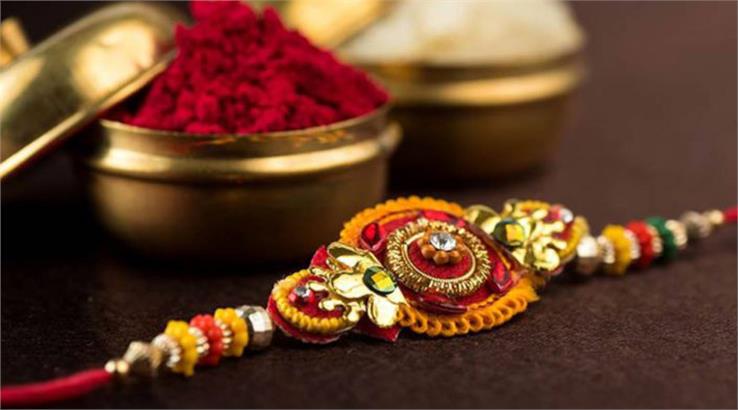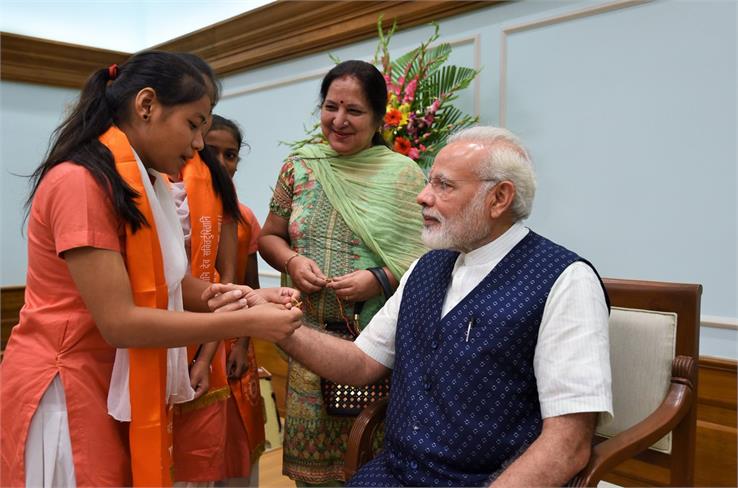Raksha Bandhan - The Bond of Protection
Raksha Bandhan—the bond of protection—is the annual festival celebrated by Hindus in every corner of the world. This festival is a symbol of love and affection between sisters and brothers. It is celebrated on the first full moon day (Rakhi Purnima) of the lunar month Shravana (the 5th month as per Hindu calendar).
On the day of Raksha Bandhan, the sister first applies tilak on the forehead of her brother and then ties a rakhi (a traditional holy thread) on his wrist and at last, serves him some sweets. While tying the rakhi, the sister prays for her brother's long life, well-being, and the brother promises to protect her from every harm — this ritual followed by an exchange of gifts, feast, and a family get-together.
The streets of markets look colorful, full of rakhis of various varieties. The markets are filled with giggles and the dilemma of choosing the best rakhi.
History
The origin of Raksha Bandhan dates back to thousands of years ago. Even though there is no concrete reason/description of this festival, there are many stories that are believed to be the origin of this auspicious festival.
- Krishna and Draupadi
The most ancient tale of Raksha Bandhan is during the period of Mahabharata. One the day of Makar Sankranti, Lord Krishna cut his finger while handling sugarcane. His wife, Queen Rukmini, sent someone to bring bandages. On seeing this, Draupadi (wife of Pandavas) tore a small piece of her saree and wrapped it around the finger of Lord Krishna. As an expression of gratitude, Lord Krishna promised Draupadi to help her in need. To keep his promise, Lord Krishna came to the rescue of Draupadi when Kauravas were disrobing her in front of everyone.
- Yama and the Yamuna
According to Hindu Mythology, the ritual of Raksha Bandhan was followed by Yama and Yamuna. When the Yamuna river flows in India, tied a rakhi to her brother Yama, the Lord of Death, Yama granted her immortality. Moved by the gesture of rakhi and the affection attached to it, Yama declared that any brother, who'd have a rakhi on his wrist and protect his sister, would also become immortal.
- Rani Karnavati and Emperor Humayun
This controversial story states another origin of Raksha Bandhan revolving around Rani Karnavati and Emperor Humayun. Rani Karnavati, the widow of Rana Sanga, was ruler Mewar in the name of his elder son Vikramjeet. When Bahadur Shah attacked Mewar, Rani Karnavati sought help from Emperor Humayun by sending him a rakhi. Humayun was already in another military campaign when he received this message and decided to set off for Mewar. Although he reached too late, as Bahadur Shah had already conquered Mewar and Rani Karnavati was dead, but to protect his vow, he forced Bahadur Shah to leave the place. He rightfully restored the kingdom to Rani Karnavati's son Vikramjeet.
- Roxana and King Porus
One of the most famous versions of the history of Raksha Bandhan is Roxana and King Porus. This tale dates back to 326 BC when Alexander the Great invaded India, his wife Roxana (Roshanak) sent a sacred thread to Porus, the King of Kaikeya kingdom, requesting him not to harm her husband in the battlefield. When the two kings met on the battlefield, King Porus looked at the rakhi on his hand and decided not to attack Alexander, personally. Porus ultimately lost the battle but won the respect and honor of Alexander.
- Rabindranath Tagore and the Bengal partition of 1905
Rabindranath Tagore, the Bengali Polymath, evolved the idea of Raksha Bandhan and used this concept to inspire love, respect, and a vow of mutual protection between Hindus and Muslims during India's colonial era. Rabindranath Tagore organized a ceremony to celebrate Raksha Bandhan between Hindus and Muslims of Bengal to spread the message of love and brotherhood. Tagore's motive was also to urge them to protest the British Empire together. Although his campaign proved out to be unsuccessful, Bengal split into two parts-one became modern Bangladesh, a predominantly Muslim country, and another became West Bengal, a Hindu Indian state. Even though his requests went in vain, Rabindranath Tagore kept celebrating Rakhi Mahotsava as a symbol of Bengal unity, and the legacy is continued to this date.
Raksha Bandhan and its different forms
Raksha Bandhan is an auspicious and most celebrated day in the Hindu calendar, but the festival holds different meaning and significance in different regions of India.
- Narali Purnima or Nariyal (coconut) Purnima
The day of Raksha Bandhan is celebrated as The Narali Purnima in western India, including Gujarat, Goa, and Maharashtra. On Narali Purnima, the monsoon starts retreating, and wild waves of sea calm down. The fishermen welcome the new fishing season by offering coconuts to the sea and thanks lord Varuna (the Hindu Lord of Sea).
- Upakarma or Avani Avittam
The day of Raksha Bandhan is celebrated as Upakarma or Avani Avittam in South India. On this day, the Brahmins change their holy thread called "Janeyu" and consider it a reparation of all their wrongdoings in the previous year.
- Kajari Purnima
The day of Raksha Bandhan is celebrated as Kajari Purnima in Chhattisgarh, Madhya Pradesh, Bihar, and Jharkhand. The festival carries a great value for farmers, as from this day, the sowing season of wheat and barley begins. The rituals of the festival are performed by women who have borne sons. The women collect soil from their fields in a cup made of leaves and then place it in a dark room in the house. The cup is worshipped for seven days before being immersed in a pond or a river.
- Pavitropana
The day of Raksha Bandhan is celebrated as Pavitropana in some parts of Gujarat. The people of Gujarat believe that worshipping Lord Shiva, on this day, can get them rid of all their sins.
- Jhulan Purnima
The day of Raksha Bandhan is celebrated as Jhulan Purnima in Eastern parts of India, including West Bengal and Odisha. This festival is celebrated to mark the romance between Radha and Krishna.









